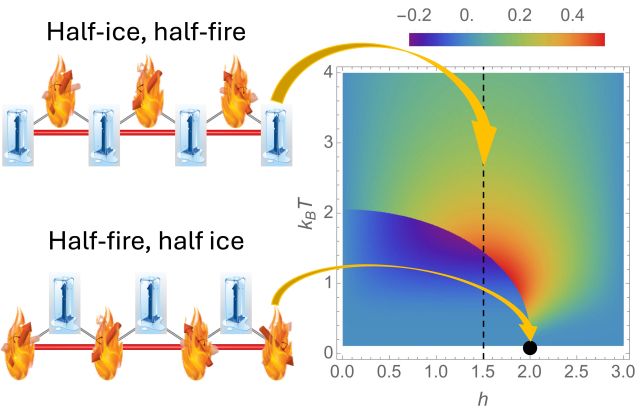An exotic state of matter has been found lurking within a previous exotic state that was discovered in a magnetic compound last decade.
In 2016, physicists Weiguo Yin, Christopher Roth, and Alexei Tsvelik of Brookhaven National Laboratory in the US identified what they referred to as a "half-fire, half-ice" phase of spin-states in Sr3CuIrO6, a mix of strontium, copper, iridium, and oxygen.
Now, they have found the opposite: a half-ice, half-fire phase, in which the electrons within two different structures swap behaviors.
Critical to the discovery is a concept referred to as frustration, a description of interactions between neighboring particles. Change one piece of the puzzle, a change in behavior can ripple across the board as a phase shift.
In the team's half-fire, half-ice material, spins of electrons on a lattice of copper atoms are disordered like the flickering flames of an inferno. Those of the iridium sites are frozen in place, giving them a stronger magnetic pull.
Getting this formation to budge seemed impossible according to a mathematical standard of phase shifting. Yet a critical finding has led the team to find a definite change in temperature that flips the whole state around.
This reversibility is the breakthrough Yin and Tsevik were looking for – the key to unlocking Sr3CuIrO6's potential for quantum information science and microelectronics.
"Finding new states with exotic physical properties – and being able to understand and control the transitions between those states – are central problems in the fields of condensed matter physics and materials science," Yin says.
"Solving those problems could lead to great advances in technologies like quantum computing and spintronics."
Magnetic materials can take several different forms. In the conventional ferromagnetic material, such as iron, the spins of the particles therein are all aligned in the same direction. A ferrimagnet is one in which two spin states are found, like Sr3CuIrO6.
As laid out in the team's 2024 paper of their 2016 discovery, the strange, half-fire, half ice phase can be induced by an external magnetic field, and it's quite striking. The copper spins fall into a disordered omnishambles, while the iridium spins regiment themselves like soldiers at attention.
That's pretty interesting, but not hugely useful on its own. Qubits, for instance – the basic units of quantum computing – can be based on electron spins, but those spins need to be able to display the different values of the binary system. And tunable qubits – ones whose spins can be manipulated – are even more useful.
"Despite our extensive research, we still didn't know how this state could be utilized, especially because it has been well known for one century that the one-dimensional Ising model, an established mathematical model of ferromagnetism that produces the half-fire, half-ice state, does not host a finite-temperature phase transition," Tsvelik explains.
"We were missing pieces of the puzzle."

Those pieces have come together in the team's new work. They discovered that, within a very narrow, finite temperature range lurks a hidden twin to half-fire, half-ice; that is, half-ice, half-fire, in which the copper becomes ordered and the iridium falls into disarray.
This doesn't just open up avenues for future research into hidden phases and their transitions; it also means that the phase change can be tightly controlled, opening up an entire realm of potential quantum applications.
It's important to note, however, that this is just a step in the journey.
"Next, we are going to explore the fire-ice phenomenon in systems with quantum spins and with additional lattice, charge, and orbital degrees of freedom," Yin says. "The door to new possibilities is now wide open."
The research has been published in Physical Review Letters.
